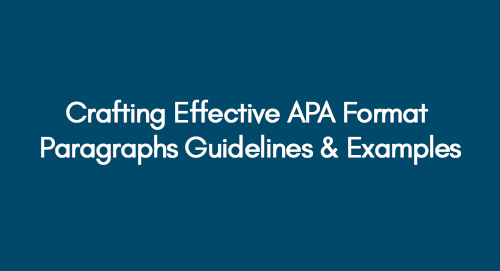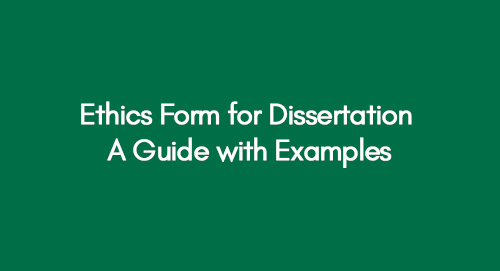
Dissertation Gantt Chart | Guide & Templates
June 14, 2023
How to Create an Effective APA Running Head: Examples & Tips
June 16, 2023The American Psychological Association (APA) format is a standard often used in academic or dissertation writing, particularly in the social and behavioural sciences.
Crafting Your Thesis with the APA Dissertation Format
Understanding how to structure APA format paragraphs, from the first line indent to the paragraph indentation APA style requires, is essential for crafting a well-formatted paper. In this article, we delve into the particulars of the APA format, including the indenting paragraphs APA style, the APA indent size, and more.
What is APA Format Paragraph?
An APA format paragraph follows a specific structure that aligns with the readability and clarity APA values. Each paragraph should start with an APA paragraph indent, which standardly is a half-inch from the left margin. This APA first line indent sets the tone for a neat, professional appearance.
One of the common questions asked by students and researchers alike is, "Do you indent paragraphs in APA style?" The answer is a resounding yes. All paragraphs in an APA-styled paper need to be indented, reinforcing consistency across the document. This rule applies whether you're crafting the introduction, body, or conclusion of your work.
Steps to Crafting Effective APA Format Paragraphs
Crafting effective APA format paragraphs involves proper structuring, referencing, and adherence to APA style guidelines. Here are some tips to consider:
- Proper Structuring
Like any good paragraph, the first sentence should introduce your main idea or point (the topic sentence). This will be followed by supporting sentences that elaborate on your point. The final sentence can sum up your argument or provide a transition to the next paragraph.
- In-Text Citations
When citing sources within the text, the author’s last name and the publication year are usually enough. In general, APA in-text citations follow the author-date method. For example: (Smith, 2020).
- Direct Quotes
If you are quoting directly from a source, you need to include the page number. For example: (Smith, 2020, p. 32). Direct quotes should be used sparingly and only when necessary, as paraphrasing and summarizing are often preferred.
- Paraphrasing
When you paraphrase information from a source, you are not required to provide a page number, although it's often encouraged to do so. Paraphrased in-text citation might look like this: (Jones, 2019).
- Avoiding Bias
APA emphasizes the use of language that is free from bias and judgments. Therefore, when writing your paragraph, be careful to avoid language that might be construed as bias or discriminatory.
- Using the Third Person
The APA style encourages using the third person perspective and avoiding the first person. However, in recent years, the 7th edition of the APA Publication Manual has become more flexible about using the first-person perspective when it's necessary.
- Consistent Tense
Generally, you should use the past tense or present perfect tense for the explantation of the procedure or the discussion of the data in your study.
- Clarity and Conciseness
Your paragraphs should be clear and to the point. Avoid unnecessary jargon, and be sure to explain any technical terms that your reader might not understand.
- Logical Flow
Your paragraphs should flow logically from one to the next. This means each paragraph should have a clear focus, and it should be clearly linked to the paragraphs before and after it.
By keeping these tips in mind, you can create effective APA format paragraphs that are properly structured, referenced, and compliant with APA style guidelines.
Indenting Paragraphs APA Style: How To
Knowing how to indent paragraphs in APA style is key to maintaining the format's consistency. The default setting on most word processing software is usually adequate for an APA indent, but it’s always prudent to check. Your first line of each paragraph should be indented a half-inch from the left margin, which can typically be achieved using the tab key.
APA Indent Size and Format
As mentioned, the standard APA indent size is a half-inch. It’s crucial to maintain this size throughout your document to ensure uniformity and readability. The APA indentation rule is applied in both the APA 7 paragraph format and its earlier versions.
When it comes to indenting paragraphs, the APA style discourages the use of extra spaces between paragraphs. The standard APA style paragraph should start with an indent and have no additional spaces between paragraphs. This approach, along with the APA indent, allows your reader to easily follow your ideas and arguments.
Examples of APA Paragraph Indentation
Here are some examples of how your APA style paragraphs should look:
- Regular paragraph: The first line of the paragraph is indented 0.5 inches from the left margin. The rest of the paragraph is left-aligned.
- Block quotation: A block quotation is indented 1 inch from the left margin. The first line of the block quotation is also indented 0.5 inches. The rest of the block quotation is left-aligned.
- Heading: A heading is indented 0.5 inches from the left margin. The heading is not left-aligned but is centered on the line.
- Abstract: The abstract is not indented or aligned. The abstract is typed in a single-spaced font, and is usually no more than 250 words long.
Adhering to the APA Paragraph Format
Remember, following the APA paragraph format is not just about aesthetics. The APA indention and APA format indent guidelines are designed to enhance readability, making it easier for readers to follow the flow of your thoughts and ideas. The uniformity in the paragraph format also reflects the writer's attention to detail and adherence to academic standards.
By adhering to these guidelines, you can ensure that your academic paper or research report maintains a professional and organized structure. You'll be on your way to creating quality APA style paragraphs that are not only well-written but also well-formatted.
Always remember, while content is crucial, so is presentation. Now that you're familiar with the APA format paragraph rules and guidelines, you're all set to start writing in a professional, academic style!
Get 3+ Free Dissertation Topics within 24 hours?



























